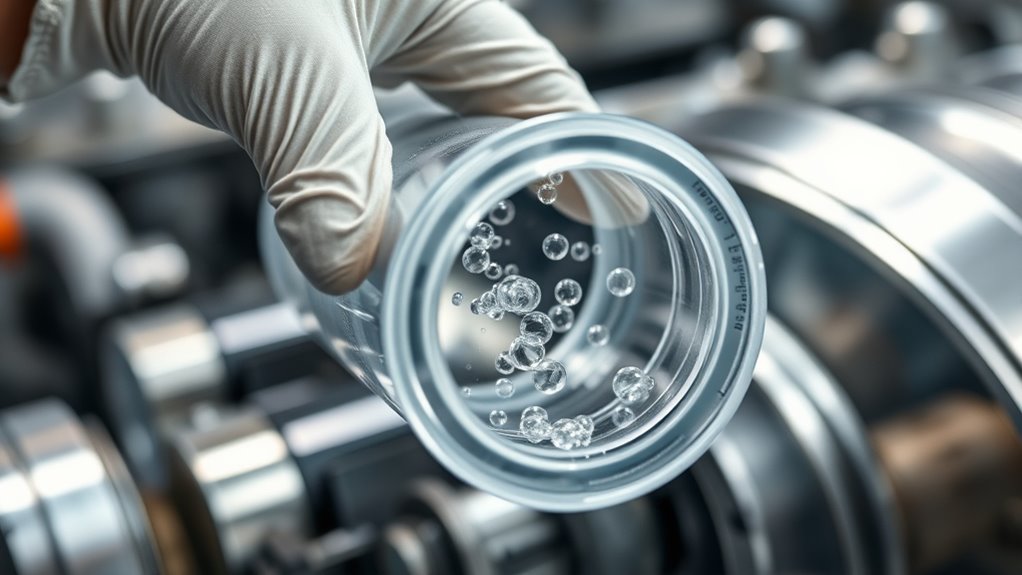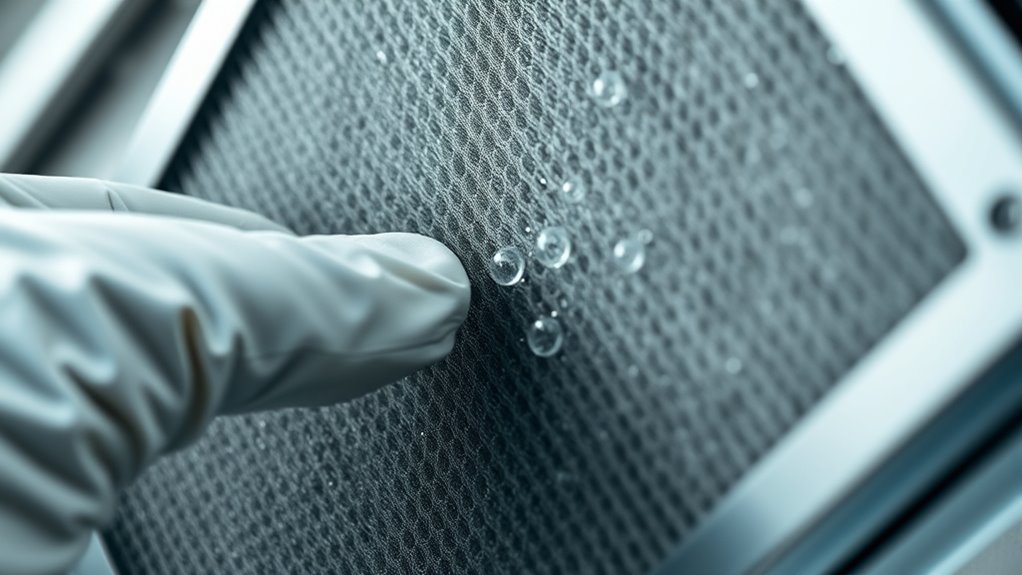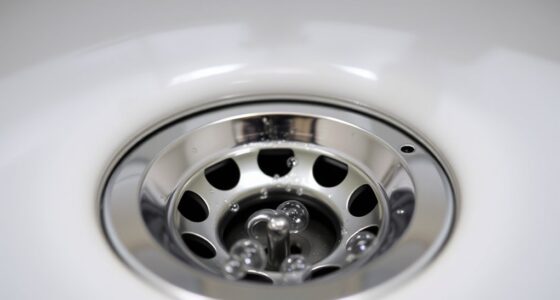If you find trapped air in your filter, first check for loose or improperly sealed connections, as these often cause air bubbles. Turn off the system and gently bleed the trapped air with an air vent or release valve if available. You can also tap or tilt the filter to dislodge bubbles. Regular maintenance and correct installation help prevent air entrapment, so explore more to keep your system running smoothly and efficiently.
Key Takeaways
- Proper installation and sealing of filters prevent air from becoming trapped during setup.
- Regularly check for air pockets and signs of reduced flow or efficiency in the system.
- Use manual air-release valves or vents to safely bleed trapped air after maintenance.
- Gently tap or tilt the filter during startup to help dislodge and release air bubbles.
- Maintain tight connections and follow manufacturer guidelines to minimize air entrapment and ensure optimal performance.

Have you ever noticed a decrease in your filter’s performance? If so, trapped air might be the culprit. Air bubbles can get trapped inside your filter, disrupting the flow of water or air and reducing its efficiency. Addressing this issue begins with proper filter maintenance, which includes regularly checking your filter for signs of air pockets. When you notice a sudden drop in performance, it’s often because air bubbles are blocking the filter’s pathways, preventing it from functioning as it should. Removing these air bubbles is essential to restore ideal operation and prolong the life of your filter system.
Notice decreased filter performance? Trapped air bubbles may be blocking flow—regular maintenance helps prevent and fix the issue.
The first step in dealing with trapped air is to understand how air bubble formation occurs. Usually, it’s because of improper installation, a recent cleaning, or fluctuations in water pressure. When you set up or clean your filter, air can get trapped inside, forming bubbles that hinder filtration. During operation, these bubbles tend to collect at the top or in specific areas, creating a barrier that restricts water or air flow. This not only hampers filtration efficiency but can also cause noise and increased wear on your system. To prevent this, consistent filter maintenance is key—checking for air pockets and ensuring all connections are tight and properly sealed.
To remove air bubbles effectively, start by turning off your filter and gently bleeding the trapped air. Many filters have a manual air-release valve or a designated air vent; use these to release the built-up air. If your filter lacks such a feature, you can often achieve air bubble removal by gently tapping or shaking the filter to dislodge the bubbles, then restarting the system slowly. When restarting, do it gradually to allow air to escape naturally without creating new pockets. Sometimes, tilting or repositioning the filter during restart helps air bubbles rise and escape more easily. Regularly inspecting and maintaining your filter, especially after cleaning or maintenance, reduces the chances of trapped air forming in the first place. Proper installation and sealing are crucial factors in preventing air entrapment and ensuring optimal filter function.
In addition to manual methods, installing a filter designed with automatic air removal features can make your maintenance routine easier. These filters are built to release trapped air continuously, eliminating the need for manual intervention and ensuring consistent performance. Remember, small efforts in filter maintenance, like regular inspections and air bubble removal, can markedly improve your filter’s lifespan and efficiency. Maintaining a routine helps you catch trapped air early, preventing larger problems down the line. With consistent care, you’ll keep your filter running smoothly, ensuring clear, healthy water or air flow at all times, and avoiding the frustration caused by trapped air disrupting your system’s performance.
Frequently Asked Questions
How Does Trapped Air Affect Filter Lifespan?
Trapped air shortens your filter’s lifespan because it reduces filter efficiency, causing it to work harder and wear out faster. This means you’ll need more frequent replacements, which can increase maintenance costs. To prevent this, you should regularly check your filters, follow your maintenance schedule, and guarantee proper installation. Addressing trapped air early keeps your filter functioning at its best, extending its life and maintaining system efficiency.
Can Trapped Air Cause Equipment Damage?
Yes, trapped air can cause equipment damage. When air gets stuck in the filter material due to installation errors, it creates pressure points that strain the system. This buildup can lead to vibrations, leaks, or even cracks over time. Ignoring these signs puts your equipment at risk, so always guarantee proper installation and check for trapped air to prevent costly repairs or irreversible damage.
Are Certain Filter Types More Prone to Air Entrapment?
Yes, certain filter materials are more prone to air pocket formation, leading to air entrapment. For example, foam filters and those with porous or uneven surfaces tend to trap air more easily. You should pay attention to the filter material because it directly influences how well air escapes during installation. Choosing filters with smooth, dense materials can reduce the likelihood of air pockets forming, ensuring ideal performance and longevity.
How Often Should I Check for Trapped Air?
Did you know that improper inspection frequency can reduce filter efficiency by up to 15%? You should check for trapped air during your regular maintenance schedule, ideally every 1 to 3 months. Regular inspections help catch air pockets early, preventing airflow issues and prolonging filter life. Stick to a consistent maintenance schedule, and you’ll keep your system running smoothly and efficiently, saving you time and costly repairs.
What Are the Best Tools for Removing Trapped Air?
To remove trapped air effectively, you should use a vacuum pump to create negative pressure, helping to extract air from the filter. A pressure gauge is essential to monitor the process and guarantee you’re reaching the right pressure level. These tools work together to make the air removal process more efficient, preventing damage or inefficiency in your system. Always follow manufacturer instructions for best results.
Conclusion
Now that you know how trapped air can turn your filters into obstacles, you’re ready to tackle the problem head-on. Picture the air bubbles like tiny balloons stubbornly stuck, blocking your filter’s flow. With a few simple steps, you’ll release that air, allowing your filter to breathe easy again. Think of it as giving your system a fresh start—like opening a window on a breezy day, inviting smooth, clean airflow back into your space.









